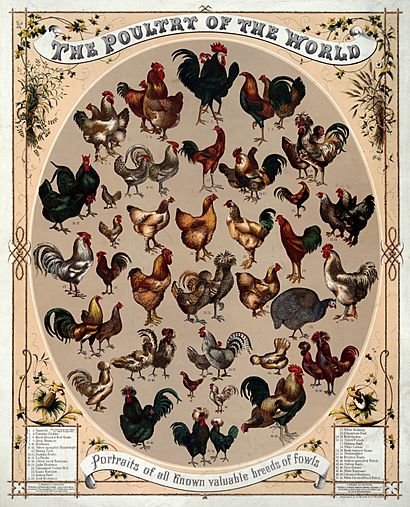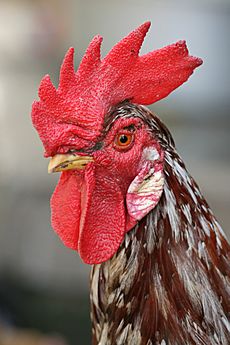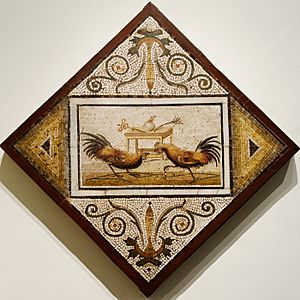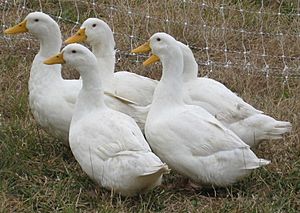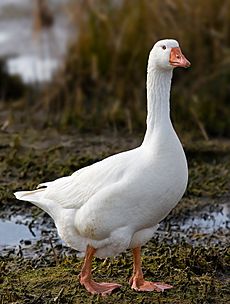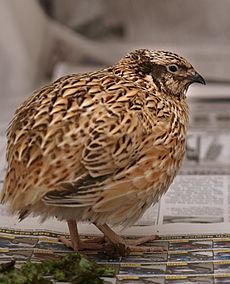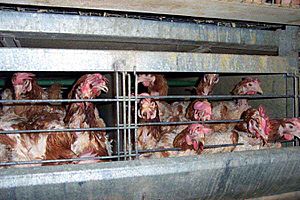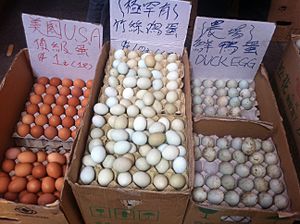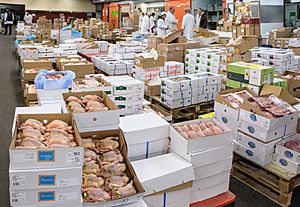Poultry facts for kids
Poultry refers to domesticated birds that people raise for their eggs, meat, or feathers. These birds are usually part of a group called Galloanserae, especially the order Galliformes. This group includes common birds like chickens, quails, and turkeys.
The word "poultry" can also include other birds raised for meat, such as young pigeons (called squabs). However, it does not include wild birds that are hunted, which are known as game. The word "poultry" comes from an old French word, poule, which means small animal.
People started domesticating poultry thousands of years ago. At first, they might have hatched eggs from wild birds. Later, they began keeping the birds in captivity all the time. Early domesticated chickens might have been used for cockfighting, and quail were kept for their songs. But soon, people realized how useful it was to have a steady supply of food from these birds.
Over many centuries, people selectively bred these birds. They chose birds that grew fast, laid many eggs, looked good, or were calm. Because of this, modern breeds often look very different from their wild ancestors. While some birds are still kept in small groups on farms, most poultry sold today comes from large commercial farms.
Poultry meat is one of the most popular meats worldwide, along with pork. In 2012, these two meats made up over 70% of the world's meat supply. Poultry provides healthy food with good protein and not much fat. It's important to handle and cook all poultry meat properly to avoid getting food poisoning.
Contents
What is Poultry?
"Poultry" is a term for any domesticated bird raised by humans for its usefulness. This usually means birds like Galliformes (chickens, turkeys) and Anseriformes (ducks, geese). It doesn't usually include cagebirds like songbirds or parrots. So, poultry can be defined as domestic birds like chickens, turkeys, geese, and ducks, raised for their meat or eggs. The word is also used for the meat itself.
Some experts also include guineafowl and young pigeons (squabs) in the definition. Others add Japanese quail and common pheasant, which are often raised in captivity. Historically, even birds like peafowl and mute swan were sometimes considered poultry because they were kept by people for various uses.
In everyday talk, "fowl" is often used to mean a "domesticated chicken" or "poultry" in general. Many languages don't have separate words for "poultry" and "fowl." Both words can also refer to the meat from these birds. Poultry is different from "game," which means wild birds or animals hunted for food or sport.
Examples of Poultry
| Bird | Wild Ancestor | Where it was Domesticated | What it's Used For | Picture |
|---|---|---|---|---|
| Chicken | Red junglefowl | Southeast Asia | meat, feathers, eggs, decoration, leather | 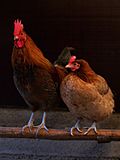 |
| Duck | Muscovy duck/Mallard | various places | meat, feathers, eggs |  |
| Emu | Emu | various places, 20th century | meat, leather, oil |  |
| Egyptian goose | Egyptian goose | Egypt | meat, feathers, eggs, decoration |  |
| Goose | Greylag goose/Swan goose | various places | meat, feathers, eggs |  |
| Indian peafowl | Indian peafowl | various places | meat, feathers, decoration, garden beauty | 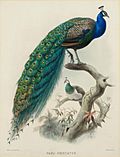 |
| Mute swan | Mute swan | various places | feathers, eggs, garden beauty |  |
| Ostrich | Ostrich | various places, 20th century | meat, eggs, feathers, leather |  |
| Partridge | Red legged partridge, Chukar partridge, Grey partridge | France, Afghanistan, United Kingdom | meat, eggs, feathers, pets |  |
| Small-billed tinamou | Small-billed tinamou | South America | meat, eggs |  |
| Pigeon | Rock dove | Middle East | meat, feathers, decoration |  |
| Quail | Japanese quail, Northern bobwhite, Common quail | Japan, Virginia, Europe | meat, eggs, feathers, pets |  |
| Turkey | Wild turkey | Mexico | meat, feathers |  |
| Edible-nest swiftlet | Edible-nest swiftlet | Indonesia, Malaysia | nests (for soup) |  |
| Grey francolin | Grey francolin | Indian subcontinent | meat, fighting, pets |  |
| Guineafowl | Helmeted guineafowl | Africa | meat, eating pests, alarm calls |  |
| Common pheasant | Common pheasant | Eurasia | meat |  |
| Golden pheasant | Golden pheasant | Eurasia | meat, mainly for decoration |  |
| Greater rhea | Greater rhea | various places, 20th century | meat, leather, oil, eggs |  |
Chickens
Chickens are medium-sized, sturdy birds that stand upright. They have fleshy red combs and wattles on their heads. Male chickens, called cocks or roosters, are usually larger and more colorful than females (hens). Chickens are social birds that eat both plants and small animals (omnivorous). In nature, they look for seeds, insects, and other small creatures on the ground. They rarely fly unless they feel in danger, preferring to run and hide.
Today's domestic chicken comes mostly from the wild red junglefowl of Asia. People believe chickens were first domesticated between 7,000 and 10,000 years ago. Some old chicken bones found in China date back to around 5,400 BC. Archaeologists think chickens were first kept for cockfighting because male birds are naturally good fighters. By 4,000 years ago, chickens had reached the Indus Valley, and 250 years later, they arrived in Egypt. The Romans used them to predict the future. The Egyptians learned how to hatch eggs artificially, which was a big step forward. Since then, chickens have spread worldwide, providing valuable eggs and meat.
Many different breeds of chickens have been created since they were domesticated. Most chickens raised for commercial purposes today are hybrid birds, meaning they are a mix of different breeds. Around 1800, people started keeping chickens on a larger scale. Modern large poultry farms began in the United Kingdom around 1920 and in the United States after World War II. By the mid-1900s, raising chickens for meat became more important than raising them for eggs.
Chicken breeding has led to different types of birds for different needs. Some lay many eggs (up to 300 a year). Others grow fast and have a lot of meat. There are also "utility" birds that produce a good number of eggs and also have a good amount of meat.
A bantam is a small type of domestic chicken. It can be a tiny version of a regular breed or a "true bantam" that doesn't have a larger counterpart. The name comes from the town of Bantam in Java, where sailors bought small local chickens for their ships. Bantams are much smaller than standard chickens and lay small eggs. People keep them for eggs, to hatch other eggs, for decoration, or for shows.
Cockfighting
Cockfighting is thought to be one of the oldest spectator sports. It might have started in Persia 6,000 years ago. In this sport, two adult male chickens (cocks) are made to fight each other. They fight fiercely until one is badly hurt or killed. Breeds like the Aseel were developed in India for their aggressive nature. This sport was part of the culture in ancient India, China, Greece, and Rome. People would bet large amounts of money on the fights. However, cockfighting has been banned in many countries in the last century because it is considered cruel to animals.
Ducks
Ducks are medium-sized water birds with wide bills and webbed feet. Their eyes are on the sides of their heads, and they have fairly long necks and short legs set far back on their bodies. Male ducks, called drakes, are often larger than females (hens) and can have different colors in some breeds. Domestic ducks eat both plants and animals (omnivores). They eat things like water insects, worms, small amphibians, water plants, and grasses. They feed in shallow water by dipping their heads underwater and tipping their tails up. Most domestic ducks are too heavy to fly. They are social birds and prefer to live and move in groups. They keep their feathers waterproof by spreading oil from a special gland over them.
Ancient clay models of ducks found in China, dating back to 4000 BC, suggest that ducks might have been domesticated there during the Yangshao culture. Even if not then, ducks were definitely domesticated in the Far East at least 1500 years before they were in the West. A Roman writer named Columella, in the first century BC, suggested that people wanting to raise ducks should collect wild duck eggs and let a broody hen hatch them. He said that ducks raised this way would "lose their wild nature and breed without hesitation when kept in a bird pen." Despite this, ducks were not mentioned in farming texts in Western Europe until about 810 AD. At that time, they started to be listed alongside geese, chickens, and peafowl as animals used for rent payments to landowners.
Most experts agree that the mallard is the ancestor of almost all domestic duck breeds. The only exception is the Muscovy duck, which is not closely related to other ducks. Ducks are mainly farmed for their meat, eggs, and down feathers. Like chickens, different duck breeds have been developed. Some are chosen for laying many eggs, and others for fast growth and good meat. The most common commercial breed in the United Kingdom and the United States is the Pekin duck. This duck can lay 200 eggs a year and can weigh about 3.5 kg (7.7 lb) in just 44 days.
In Western countries, ducks are not as popular as chickens. Chickens produce more white, lean meat and are easier to raise in large numbers, which makes chicken meat cheaper than duck meat. While duck is popular in fancy French cooking, it's less common in everyday meals. However, in the East, ducks are more popular than chickens. They are often still herded in traditional ways and are good at finding food in rice fields and other wet areas.
Geese
The greylag goose was domesticated by the Egyptians at least 3000 years ago. Another wild species, the swan goose, was domesticated in Siberia about a thousand years later. This one is known as a Chinese goose. These two types of geese can breed together, and their hybrid offspring are fertile. Many modern goose breeds come from these hybrids. Despite being domesticated early, geese have never become as important commercially as chickens and ducks.
Domestic geese are much larger than their wild relatives. They tend to have thick necks, stand upright, and have large bodies with wide rear ends. The geese that came from the greylag goose are large and meaty, used for food. Chinese geese are smaller and mainly used for egg production. The soft down feathers from both types are valuable for pillows and warm clothing. Geese eat grass and weeds, and also small insects. One good thing about raising geese is that they can grow well on a diet mostly of grass. They are very social and have good memories. You can let them roam freely, knowing they will return home by evening. The Chinese goose is more aggressive and noisy than other geese. It can even be used as a guard animal to warn of strangers. The meat of geese is dark and high in protein. They store fat under their skin, but this fat is mostly healthy. Geese are usually ready for meat at about 10 or 24 weeks old.
In some countries, geese and ducks are force-fed to make their livers very fatty. This is used to produce a food called foie gras. Over 75% of the world's foie gras comes from France. Smaller amounts are made in Hungary, Bulgaria, and China. Foie gras is seen as a luxury food in many places. However, the process of force-feeding birds is banned in many countries because of concerns about animal welfare.
Turkeys
Turkeys are large birds, related to pheasants and guineafowl. Males are bigger than females. They have large, fan-shaped tails and special fleshy growths called wattles and a snood that hangs over their beak. These are used in courtship displays. Wild turkeys can fly, but they usually prefer to run with a long, striding walk. They sleep in trees and look for food on the ground. They eat seeds, nuts, berries, grass, leaves, insects, lizards, and small snakes.
The modern domesticated turkey comes from one of six types of wild turkey found in Mexico. Ancient tribes in south-central Mexico first domesticated turkeys around 800 BC. Pueblo Indians in the United States also domesticated them around 200 BC. They used the feathers for robes, blankets, and ceremonies. More than 1,000 years later, turkeys became an important food source. When Europeans first saw the bird, they mistakenly thought it was a guineafowl, which was called a "turkey fowl" because it came to Europe through Turkey.
Commercial turkeys are usually raised indoors in controlled environments. These are often large buildings designed to provide good air flow and low light. Low light makes the birds less active, which helps them gain weight faster. Lights can be on 24 hours a day or in stages to encourage birds to eat often and grow quickly. Female turkeys are ready for slaughter at about 15 weeks old, and males at about 19 weeks. Adult commercial turkeys can be twice as heavy as wild ones. Many different breeds have been developed, but most commercial birds are white. This makes the prepared meat look better because their pin feathers are less visible. Turkeys used to be eaten mainly on special holidays like Christmas (in the UK) or Thanksgiving (in the US). However, they are now becoming a more common part of daily meals worldwide.
Quail
The quail is a small to medium-sized bird with colors that help it blend in with its surroundings. In nature, it lives in bushy areas, grasslands, and farm fields, or other places with thick cover. It eats seeds, insects, and other small creatures. Quail are mostly ground-dwelling and social, so domesticating them was not hard. However, they still keep many of their wild instincts in captivity.
The Egyptians knew about quail long before chickens arrived. Quail were shown in hieroglyphs from 2575 BC. Migrating quail would fly across Egypt in huge flocks, and sometimes people could even pick them up by hand. These were the common quail. But most modern domesticated quail are Japanese quail, which were probably domesticated as early as the 11th century AD in Japan. They were first kept as songbirds, and people think they were often used in singing contests.
In the early 1900s, Japanese breeders started to breed quail specifically to lay more eggs. By 1940, the quail egg industry was doing very well. But World War II caused almost all the quail lines bred for song and egg production to be lost. After the war, the few surviving domesticated quail were used to rebuild the industry. All commercial and laboratory quail today are thought to come from this small group. Modern quail can lay over 300 eggs a year. Countries like Japan, India, China, Italy, Russia, and the United States have large commercial Japanese quail farms. Japanese quail are also used in scientific research for things like genetics, embryology, nutrition, and pathology. These quail are closely related to the common quail. Many young hybrid birds are released into the wild each year to help increase wild populations.
Other Poultry Birds
Guinea fowl came from southern Africa. The type most often kept as poultry is the helmeted guineafowl. It's a medium-sized grey or speckled bird with a small, bare head, colorful wattles, and a knob on top. They were domesticated by the time of the ancient Greeks and Romans. Guinea fowl are tough, social birds that mainly eat insects, but also grass and seeds. They can help keep vegetable gardens free of pests and will even eat ticks that carry Lyme disease. They like to sleep in trees and make loud calls to warn of predators. Their meat and eggs can be eaten just like chicken. Young guinea fowl are ready to eat at about four months old.
A squab is the name for young domestic pigeons that are raised for meat. Like other domesticated pigeons, these birds come from the rock pigeon. Special breeds with good meat qualities are used. Pigeons lay two eggs and sit on them for about 17 days. When the squabs hatch, both parents feed them "pigeon's milk." This is a thick, protein-rich liquid produced in the parents' crop. Squabs grow quickly but are slow to learn to fly. They are ready to leave the nest at 26 to 30 days old, weighing about 500 g (1.1 lb). By this time, the adult pigeons will have laid and be hatching another pair of eggs. A good pair of pigeons can produce two squabs every four weeks during their breeding season.
Poultry Farming
More chickens are raised worldwide than any other type of poultry. Over 50 billion birds are raised each year for meat and eggs. In the past, these birds were usually kept in small flocks, finding their own food during the day and sleeping in shelters at night. This is still common in developing countries, where women often help their families by raising poultry. However, with more people and cities, most poultry production now happens in larger, more intense farms. These farms are often near where feed is grown or where meat is needed. This helps provide cheap, safe food for people in cities. How much profit farmers make depends a lot on the price of feed, which has been going up. High feed costs could slow down the growth of poultry farming.
In free-range farming, birds can roam freely outdoors for at least part of the day. Often, they are in large fenced areas, but they can experience natural conditions and act like normal birds. A more intense system is yarding. Here, birds have access to a fenced yard and a poultry house, but with more birds per space. Poultry can also be kept in a barn system. In this system, birds don't go outside but can move freely inside the building.
The most intense system for egg-laying chickens is battery cages. These cages are often stacked in many layers. Several birds share a small cage, which limits their movement and normal behaviors. The eggs roll from the cage floor into troughs outside, making them easy to collect. However, battery cages for hens have been illegal in the EU since January 1, 2012, due to animal welfare concerns.
Chickens raised quickly for their meat are called "broilers." Special breeds have been developed that can grow to a good size (about 2 kg or 4.4 lb) in six weeks or less. Broilers grow so fast that their legs sometimes can't support their weight. Their hearts and breathing systems might also struggle to provide enough oxygen to their growing muscles. The death rate for broilers (1%) is much higher than for laying birds, which take 18 weeks to reach similar weights. Processing these birds is done automatically on conveyor belts.
Both intensive (large-scale) and free-range farming have animal welfare concerns. In intensive systems, diseases can be common and spread quickly through the flock. In free-range systems, birds are exposed to bad weather and can be attacked by predators or get diseases from wild birds. Barn systems have been found to have the worst bird welfare. In Southeast Asia, a lack of disease control in free-range farming has been linked to outbreaks of avian influenza.
Poultry Shows
In many countries, there are national and regional poultry shows. At these shows, people who love birds display their poultry. The birds are judged based on specific traits and standards for their breed. The idea of poultry shows might have started after cockfighting became illegal. It was a way to keep a competitive spirit in poultry raising. Standards were created for birds that lay eggs, birds raised for meat, and birds kept just for their beauty. Sometimes, poultry shows are part of larger livestock shows. Other times, they are separate events, like the annual "National Championship Show" in the United Kingdom, organized by the Poultry Club of Great Britain.
Poultry as Food
Trade
Poultry is the second most eaten type of meat globally. It makes up about 30% of all meat produced worldwide, while pork is 38%. Sixteen billion birds are raised each year for food. More than half of these come from large, factory-like farms. Global broiler (meat chicken) production reached 84.6 million tons in 2013. The biggest producers were the United States (20%), China (16.6%), Brazil (15.1%), and the European Union (11.3%).
There are two main ways poultry is produced. The European Union tries to make sure products can be traced back to the farm where they came from. This model faces rising costs because of new food safety rules, animal welfare issues, and environmental laws. In contrast, the United States model treats poultry as a basic product.
In 2011, the world produced about 4.2 million tons of duck meat. China produced two-thirds of this total, about 1.7 billion birds. Other big duck-producing countries in the Far East include Vietnam, Thailand, Malaysia, Myanmar, Indonesia, and South Korea (together, they make up 12%). France (3.5%) is the largest producer in the West, followed by other EU nations (3%) and North America (1.7%). China was also by far the largest producer of goose and guinea fowl meat, making 94% of the 2.6 million-ton global market.
Global egg production was expected to reach 65.5 million tons in 2013, which would be a record high. Between 2000 and 2010, egg production grew by about 2% each year worldwide. Since then, growth has slowed to closer to 1%.
Cuts of Poultry Meat
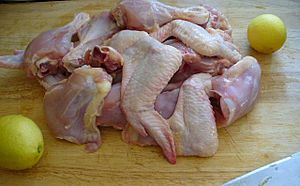
You can buy poultry fresh or frozen, as whole birds or as separate pieces (cuts). These cuts can have bones in them or be deboned. They can also be seasoned in different ways, raw, or already cooked. The parts of a bird with the most meat are the flight muscles on its chest, called "breast" meat. The walking muscles on the legs are called the "thigh" and "drumstick." The wings are also eaten. For example, Buffalo wings are popular in the United States. Wings can be split into three parts: the meatier "drumette," the "wingette" (or "flat"), and the wing tip (or "flapper"). In Japan, the wing is often separated into 手羽元 (teba-moto, "wing base") and 手羽先 (teba-saki, "wing tip").
Dark meat, which scientists call "red muscle," is used for activities that last a long time, like walking in a chicken. The dark color comes from a protein called myoglobin. This protein helps carry and store oxygen in the muscle cells. White muscle, on the other hand, is only good for short bursts of activity, like a chicken flying for a very short time. So, a chicken's leg and thigh meat are dark, while its breast meat (which is used for flying) is white. Other birds that fly for longer periods, like ducks and geese, have red muscle (and therefore dark meat) all over their bodies. Sometimes, cuts of poultry meat can show tiny, regular patterns in the muscle fibers. These patterns can bend light and create shimmering, rainbow-like colors. This is a natural optical effect called structural coloration.
|
See also
 In Spanish: Ave de corral para niños
In Spanish: Ave de corral para niños


